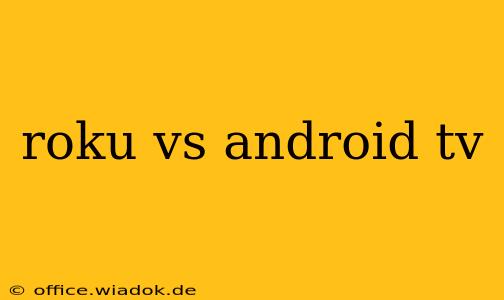Choosing the right streaming device can feel like navigating a minefield. With so many options vying for your attention, the decision often boils down to two heavyweights: Roku and Android TV. Both offer extensive app libraries, smooth interfaces, and a wide range of price points. But which platform truly reigns supreme? This in-depth comparison will help you decide.
Interface and User Experience: Simplicity vs. Customization
One of the most significant differences lies in the user experience. Roku prides itself on simplicity. Its interface is clean, intuitive, and easy to navigate, even for tech novices. Finding your favorite apps and channels is a breeze. The remote is typically straightforward, with dedicated buttons for popular streaming services.
Android TV, on the other hand, offers a more customizable experience. It leverages the power of the Android operating system, providing greater flexibility and control. While this can be a boon for power users who appreciate extensive personalization options, it can also feel overwhelming for those seeking a streamlined experience. The interface, while visually appealing, can sometimes be less intuitive than Roku's.
Key Differences Summarized:
| Feature | Roku | Android TV |
|---|---|---|
| Interface | Simple, intuitive, easy to navigate | Customizable, more feature-rich, can be complex |
| User Experience | Streamlined, beginner-friendly | Flexible, powerful, steeper learning curve |
| Remote | Typically simple and user-friendly | Varies widely depending on manufacturer |
App Selection and Content Availability: A Close Race
Both Roku and Android TV boast extensive app libraries, offering access to virtually all major streaming services like Netflix, Hulu, Disney+, and Amazon Prime Video. However, minor discrepancies can exist; a specific niche app might be available on one platform and not the other. Generally speaking, the differences are negligible for the average user. Both platforms provide access to a vast catalog of movies, TV shows, and other content.
Hardware and Device Options: Variety and Price Points
The range of Roku devices is impressive, offering options to suit various budgets and needs. From budget-friendly streaming sticks to high-end players with enhanced features like 4K HDR support, there's a Roku device for everyone. This wide selection contributes significantly to Roku's popularity.
Android TV devices also come in various shapes and sizes, ranging from affordable streaming sticks to more sophisticated smart TVs. However, the Android TV experience can vary considerably depending on the manufacturer. Some manufacturers offer highly customized interfaces and pre-installed apps, which can impact the overall user experience.
Voice Search and Smart Home Integration: Features for a Connected Life
Both platforms offer voice search capabilities, allowing you to easily find specific movies, shows, or apps using voice commands. This feature is particularly convenient for those who prefer hands-free operation.
Smart home integration is also a key feature of both Roku and Android TV. Both platforms seamlessly integrate with popular smart home devices and assistants like Google Assistant and Amazon Alexa, allowing for voice control of your entertainment and other smart home functions. The level of integration can vary depending on the specific device and its capabilities.
Conclusion: The Best Choice Depends on Your Needs
Ultimately, the choice between Roku and Android TV depends heavily on your individual needs and preferences. If you value simplicity, ease of use, and a straightforward user experience, Roku is likely the better choice. However, if you crave customization, flexibility, and a more powerful operating system with advanced features, Android TV might be more appealing. Both platforms offer excellent content libraries and a wide range of device options. Carefully consider your priorities and choose the platform that best aligns with your requirements for a seamless streaming experience.

